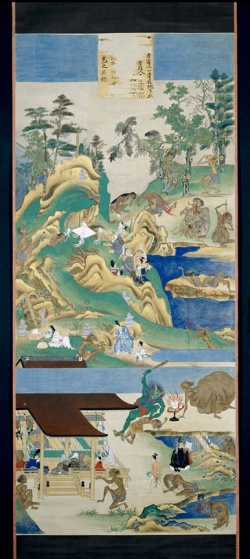Preta-gati, the Realm of Hungry Ghosts
Preta-gati, the Realm of Hungry Ghosts
Hungry ghosts (preta) are pictured as beings with huge, empty stomachs, but they have pinhole mouths, and their necks are so thin they cannot swallow.
A hungry ghost is one who is always looking outside himself for the new thing that will satisfy the craving within. Hungry ghosts are characterized by insatiable hunger and craving. They are also associated with addiction, obsession and compulsion.
Hungry Ghosts (Pretas) are pitable things. They are wasted creatures with huge, empty stomachs. Their necks are too thin to allow food to pass. So, they are constantly hungry.
Greed and jealousy lead to rebirth as a Hungry Ghost.
The Hungry Ghost Realm often, but not always, is depicted between the Asura Realm and the Hell Realm.
It is thought the karma of their lives was not quite bad enough for a rebirth in the Hell Realm but not good enough for the Asura Realm.
Psychologically, Hungry Ghosts are associated with addictions, compulsions and obsessions. People who have everything but always want more may be Hungry Ghosts.
Human beings, it is believed, exist in this endless cycle of suffering until freed through the arduous process of achieving Enlightenment, or Nirvana.
According to the seminal work Ojōyōshū (“The Teachings Essential for Pure Land Rebirth,” 984–985) by the Tendai monk Genshin (942–1017), the six realms are the possible states into which a person can be reborn.
They consist of the
realms of hell,
hungry ghosts,
demons,
beasts,
humans, and
gods.
This hanging scroll depicts the realm of hungry ghosts, the place into which the greedy are reborn as pot-bellied, narrow-throated creatures possessed of insatiable hunger and unquenchable thirst.
The excessive attachment these beings had to worldly items in their previous lives is manifest in death as a ravenous desire to consume feces, human corpses, and other vile things.
This particular work belongs to a set of ten hanging scrolls in the collection of the British Museum.
The works, of which there were probably fifteen at some point, are nineteenth-century copies of a celebrated series of thirteenth-century paintings from Ryōzen-in at Yokawa on Mt. Hiei, now housed at Shōju Raigō-ji Temple, Shiga.
The hungry ghost motif was common in the religious imagery of Japanese Buddhism, sometimes appearing in series dedicated to all six realms, as is this case here.
The large size of the works in the British Museum would have made them accessible to many individuals at once.
However, hungry ghosts are also the exclusive subject of hand scrolls created for more intimate viewing, like the Gaki Zoshi in the collection of the Tokyo National Museum.
Regardless of format, these frightening images served the same ends. Inherent in their warnings about what death might have in store were exhortations to fully embrace the principles of Buddhism.
